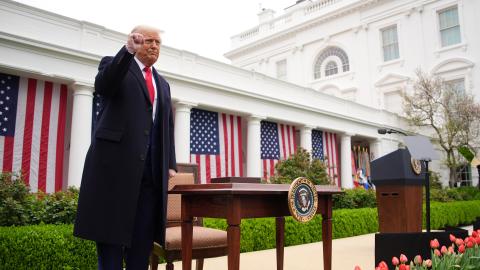In an April 2025 interview with the New York Times, former United States Secretary to the Treasury Larry Summers argued that Donald Trump’s trade policies are “the most radical trade policies and probably the most radical, rapid change in economic policies that the United States has announced since the Second World War.” Several leaders and commentators argue that, by leveling tariffs against virtually every American trading partner, Trump is relinquishing American global economic leadership, undermining free trade, winding back globalization, and transforming the US from being an outward-looking superpower into an inward-looking and selfish nation.
Now that the Court of International Trade has ruled Trump exceeded his powers under the International Emergency Economic Powers Act of 1977, the appeals process will address the legality of many of his tariffs. The decision relates specifically to the so-called Liberation Day reciprocal tariffs announced on April 2, tariffs on Canada, Mexico, and China related to fentanyl, and the 10 percent baseline tariffs on many other countries. The ruling does not affect other tariffs on steel, aluminum, and automobiles. Regardless of how the legal appeals process unfolds, one should still consider the logic behind general tariffs and how such measures ought to be assessed as an instrument of policy.
In many cases, assessments of Trump’s trade policies reflect analysts’ enduring critical or supportive views of Trump’s broader policies, character, and leadership style. The emotive response to tariffs is also unusual in that a tariff is simply another form of a tax applied to goods entering the US market.
True, unlike many other taxes, tariffs target foreign-made rather than domestic goods and tend to trigger more serious diplomatic reactions than a domestic tax would. Even so, many countries levy tariffs and use other restrictions against imports into their economies. One might debate the methodology behind the calculation of so-called reciprocal tariffs against many US trading partners, but virtually all US trading partners are undeniably imposing protectionist measures against American goods. Such measures protect local firms and industries and should not be understood as a diplomatic slight or attack against the US. In this sense, some visceral reactions to Trump’s tariffs seem disproportionate and even hypocritical.
Indeed, the European Union’s Carbon Border Adjustment Mechanism (CBAM) will, beginning in 2026, impose a carbon levy on imported emissions-intensive goods based on their quarterly carbon content. The CBAM is designed to incentivize non-EU firms to reduce their carbon emissions if they seek to export their goods into the EU. One purpose of the CBAM is to offer advantages to European firms that have reduced their carbon emissions over firms that have not. Putting aside whether one agrees with the decarbonization project, both the CBAM and Trump’s tariffs change the incentives for firms moving goods into the European and American markets, respectively.
As with all other protectionist measures, Trump’s tariffs manipulate the cost-benefit calculations for firms. If a business assesses that the tariff burden is too onerous, it will presumably make a commercially rational decision to either add more US-produced content into the product or abandon the American market.
The point is that the imposition of a tariff or any other tax requires a policy debate rather than a moral one. Instinctive outrage that Trump’s trade policies are undermining globalization and free trade, or are an insult to allies and partners, presupposes that globalization is an uncontested virtue, free trade (defined as the absence of tariffs) exists, and a tax on imported goods from a friendly country is an inherently hostile act—all contestable presuppositions.
Instead, analysts should assess Trump’s tariffs based on whether they advance the policy objectives the administration is pursuing: reindustrializing America, raising revenue, increasing wages and productivity, and accelerating American leadership and innovation in strategic sectors such as artificial intelligence (AI).
Furthermore, the tariffs against China have an explicit geopolitical element, and US tariffs against allied or friendly economies have possible geopolitical ramifications. Therefore, a dispassionate assessment of Trump’s trade policy also requires analysis as to whether the trade policies enhance or weaken America’s geopolitical leverage and standing vis-à-vis China.
This policy memo looks at the structural drivers of the changes in US trade policy and why the current administration’s actions should not be dismissed or ridiculed as Trumpian irrationality, vandalism, or malice. Upcoming Hudson Institute briefs will assess whether Trump’s trade policies are achieving the intended policy objectives and outcomes, and whether they are advancing (or hindering) the geopolitical goals of the administration.
The Argument for Trump’s Tariffs
The charge that the Trump administration is launching an assault against free trade assumes that a free trade system existed prior to Trump regaining power. The reality is that free trade has never really occurred. The existing system is an evolving and messy patchwork of tariff and non-tariff protectionist measures imposed by all countries to varying degrees under World Trade Organization (WTO) rules and principles—what some soothingly call the global economic rules-based order. The question is, Why did previous administrations broadly support this messy arrangement for decades, and why is Trump now seeking to upend it?
The answer is that many Americans tolerated and celebrated the previous system because it lowered the cost of goods for consumers and inputs for firms, which was trade’s purpose and virtue above all other considerations. Such a perspective remains intuitively seductive. It is based on the idea of competitive advantage, which can be traced back to eighteenth-century economists such as David Ricardo. According to this framing, countries export what they are good at producing and import those goods and services that others can produce better or cheaper. In general terms, the freer the trade, the better off everyone becomes.
This theory and logic do not fully resonate with the Trump administration or a significant number of Americans. Though the administration does not necessarily dismiss the theory, the White House seems to view it as limited and incomplete. According to the administration, the long-standing anti-tariff mindset elevates and prioritizes consumers’ short-term interests above all else in a way that is increasingly detrimental to society and the national interest. As the reasoning goes, such an overarching focus on consumer welfarism has a cost. Free trade is disinterested in whether other needs of the community and nation are advanced.
For the current administration, cheap and reliable energy production and manufacturing remain essential to the long-term prosperity and security of all large nations and complex societies. Presumably, this is because energy is the lifeblood of almost all economic activity, while making things (not just providing services) is the foundation for industrial resilience. After all, the US was victorious during the two world wars because it could quickly transition and transform into a wartime economy to produce high amounts of armaments and other necessities.
The administration might well argue that economists railing against tariffs are overly wedded to maximizing consumerism in the immediate term and have lost sight of the national and social importance of making things. Indeed, supporters of Trump’s trade policies can point to no less an authority than Adam Smith, who argues in The Wealth of Nations that “some burden upon foreign (entities) for the encouragement of domestic industry” is appropriate when doing so is required for national security.4 In the eighteenth century, this presumably referred to things such as ship sails and gunpowder. In the modern world, defense and national security cover much more, from critical minerals and steel to industrial chemicals and AI data centers. Additionally, the COVID-19 pandemic revealed that many other sectors are critical.
Manufacturing is also essential for innovation. For example, in the case of Taiwan, it was not the invisible hand but a deliberate policy decision that enabled the country to lead the world in semiconductor fabrication. Such policies lead to other supposedly “natural” advantages. In contrast, a country cannot easily create clusters of innovation if it does not produce real goods. Therefore, the reindustrialization of America and revival of manufacturing and innovation appear to be the driving force behind Trump’s trade policy, which uses tariffs to give domestic producers an advantage in the US market.
The administration concedes that its tariff strategy will fail if it doesn’t lower costs and increase efficiency in other areas. Therefore, it is rolling out policies related to energy, deregulation, industrial relations, and taxation to assist and incentivize American-based firms on the supply side.
Structural Reasons for American Dissatisfaction
The rise and success of the so-called East Asian model of economic development and America’s role in enabling it best illustrate the roots of trade imbalances and Trump’s dissatisfaction with the global trading system.
Since the Second World War, rapidly developing East Asian economies—including Japan, South Korea, Taiwan, Singapore, Malaysia, Thailand, and, most recently, China—have relied upon a remarkably similar export-manufacturing model. They grew by exporting products for consumers in fully industrialized economies more cheaply, quickly, and reliably than other countries or regions could.
At its heart, the East Asian approach emphasized a strong export-manufacturing sector while protecting the domestic consumption market. In addition to having relatively cheap and plentiful labor, these countries used state interventionist policies to attract foreign firms and capital into their export-manufacturing sectors. These policies included tax concessions and subsidies for domestic and foreign firms that located manufacturing plants in their countries. East Asian states also boosted exports by artificially suppressing the value of their domestic currencies relative to Western currencies, making their goods cheaper for Western firms and consumers. Furthermore, advances in logistics and transportation made transporting goods more economical, which boosted exports.
The East Asian manufacturing trade as a proportion of the global manufacturing trade has increased from about 12 percent in 1970 and 26 percent in 1990 to almost 50 percent now. The region’s share of global manufacturing added value is around 55 percent.7 The Association of Southeast Asian Nations' share of global goods exports increased from a minuscule 0.3 percent in 1970 to about 8 percent currently. In 1990, at the peak of Japan’s economic rise, its share of global goods exports exceeded 12 percent. Now China is the top performer, increasing its share of global goods exports from 0.5 percent in 1970 to around 32 percent today. In the same period, the United States’ share of global manufacturing output declined from around 23 percent (which was the highest of any economy at the time) to around 15 percent.
The US played a pivotal role in nurturing these trends in trade and manufacturing. High- and middle-income economies such as Japan, South Korea, Taiwan, Singapore, Malaysia, and China all began by importing innovation and know-how. This occurred primarily when advanced-economy firms established operations in developing, export-reliant economies, which facilitated transfers of knowledge.
For the past few decades, firms from advanced economies—the US and Europe at first, followed by Japan and South Korea—have been the leading sources of foreign direct investment (FDI) into East Asia. Meanwhile, developing giants such as China have not been a top source of FDI for any of East Asia’s export-oriented economies. Two-thirds to four-fifths of all FDI into East Asia goes to the manufacturing sector, which advanced-economy firms dominate. Firms based in advanced economies are behind roughly two-thirds of all manufactured goods exported out of East Asia, with the figure rising to above 80 percent for countries like Malaysia.
Besides dominating regional manufacturing, advanced-economy firms were essential for developing the domestic capabilities of East Asian economies. Manufacturing drives over three-quarters of all research and development in the region, most of which foreign firms conduct. In China, Japan, and South Korea, the manufacturing sector accounts for the lion’s share of national research and development. Export-driven industrialization and innovation were crucial for Japan in 1990 when the country ranked second globally in manufacturing output by value, and for China when it claimed this spot in 2010.
This arrangement suited America well in the latter part of the previous century and perhaps the first decade of this one. The combined population of Japan, South Korea, and Taiwan in 1970—when these countries were pioneering the export-manufacturing path—was only about 150 million. At the time, the combined population of the industrialized economies in North America and Western Europe, the main markets for Asian economies, was around 400 million people.
This dynamic has dramatically flipped. There are approximately 1 billion consumers in the handful of advanced economies, while there are some 2 billion people living in developing East Asian countries. Sluggish rates of population and economic growth in many advanced economies mean the imbalance will not change substantially, even if one includes the over 100 million Chinese consumers with significant buying power. Furthermore, other low-wage countries with large populations, such as Mexico, Ethiopia, or Nigeria, will also likely try to break into the export-manufacturing game.
Some economists see this situation—in which several countries use protectionism to prioritize production at the expense of consumption, and others consume more than they produce (such as the United States)—as a serious and worsening imbalance in the fundamental structure of the global economy.
For example, Michael Pettis focuses on the fragility and flaws of a global system in which economies, such as those in East Asia, achieve high growth by explicitly subsidizing production or by lowering the cost of production through policies that deliberately keep wage growth below productivity increases. These economies prioritize overproduction and encourage underconsumption, and they can effectively export their domestic imbalances to economies where governments have less control over their trade and capital accounts—such as the US. An economy fueled by industrial policies that lower the cost of manufacturing will generally cause a trading partner’s manufacturing output to contract if that country does not implement similar policies.
In this context, the Trump administration has seemingly concluded that the economic and social costs of importing lower-cost goods outweigh the benefits. When justifying the so-called reciprocal tariffs on April 2, 2025, Trump explained:
[The] lack of reciprocity in our bilateral trade relationships, disparate tariff rates and non-tariff barriers, and US trading partners' economic policies that suppress domestic wages and consumption . . . constitute an unusual and extraordinary threat to the national security and economy of the United States. That threat has its source in whole or substantial part outside the United States in the domestic economic policies of key trading partners and structural imbalances in the global trading system.
Note that this explanation for American dissatisfaction omits the role the United States has played. For decades, US firms have minimized costs and maximized productivity by sourcing capital, materials, people, and partners from virtually anywhere in the world. So America has been a central and even dominant actor in the rise of economic globalization. In this sense, Trump’s trade policies are an assault against long-standing American trade orthodoxy. Therefore, the most vocal critics of his trade policies are unsurprisingly American defenders of the previous system and not just voices from the economies facing US tariffs.
The Special Case of China
In the era of uncontested US power, such as during the early post–Cold War era, experts generally viewed the rapid advance of economic globalization and interdependence between nations in one of two ways:
- The more nations participate in global trade and become interdependent vis-à-vis the advanced liberal democratic nations, the more their values and interests will align with those of the US.
- Globalization and interdependence were strategically indifferent and functional phenomena that facilitated international trade, the movement of people and capital, and other cross-border transactions.
More than any other factor, the unique case of China has caused analysts to reassess and lose faith in these two assumptions. This is most apparent in the frequent lamentations about Chinese economic and trade practices and frustrations about international institutions such as the WTO, which are designed to facilitate cross-border transactions.
In focusing on the China case, one should avoid inaccurate analogies. Some deflect from the reality of Chinese economic misbehavior by arguing that Americans are unnecessarily worried, just as they were when the Japanese economy rose in the 1980s. This comparison is superficial and misleading. Japan was (and remains) an American ally and did not demonstrate any will or ability to challenge US strategic preeminence or change the international order more broadly.
Moreover, the challenge posed by China is quantitatively different. For America, the scale of Chinese offenses and their perceived impacts on the US economy make them too serious to ignore. In 2018, during the first Trump administration, US-China trade was worth more than $660 billion. This decreased to a still substantial $582 billion in 2024. Constituting the heart and bulk of the vast East Asian manufacturing zone, China is entrenched as the world’s largest manufacturing economy and the largest trading partner for over 100 countries.
There’s another, more important distinction between Japan in the 1980s and contemporary China. In addition to the Chinese economy’s larger impact, more analysts recognize that the problems are systemic and will worsen because they stem from the fundamental nature of China’s political economy. The existing and so-called rules-based economic system is predicated on entities competing against each other through a commercially driven process. That liberal system reduces and circumscribes the role and capacity of governments (and political parties) to intervene in economic activity.
The problem with China is unique because its political economy will not leave the commercial fate of its companies to the gods of competition, competence, or chance. More than any other major economy, it’s prepared to use state power, laws, regulations, and resources to:
- Subsidize Chinese firms in key sectors at an unprecedented level and scale that is incomparable with any other economy to crowd out international competitors
- Ensure that state-owned enterprises (SOEs) and national champions dominate targeted sectors, domestically and internationally
- Lock in guaranteed external markets for those SOEs and national champions, especially through its Belt and Road Initiative and the Digital Silk Road
- Support forced or illegal intellectual property (IP) transfers to allow SOEs and national champions to compete and eventually dominate
- Rely on opaque and even corrupt political deals to create economic footholds for Chinese entities
These approaches inherently undermine what globalization and interdependence were supposed to facilitate and enhance: the maximization of efficiency and the creation of new opportunities for participants based on market forces. China’s approach to the global economy reflects its own domestic political-economic setup, which ensures that the Chinese Communist Party (CCP) retains the levers of economic power and relevance. While all governments intervene in the domestic and global economy to some degree, the nature, scale, and extent of intervention by the CCP and Chinese state mean that authoritarian China plays a vastly different game from other major economies in the global system.
For example, an Organisation for Economic Co-operation and Development (OECD) report on industrial subsidies, covering almost 500 of the world’s largest manufacturing companies from over 50 countries, found that Chinese subsidies given to local firms surpassed the assistance other governments offered by a considerable margin. In many cases, Chinese subsidies in sectors considered critical to national prosperity and strength, and in which global competition is most fierce, exceeded 15 percent of revenue. The companies that made the top 14 largest gains in market share in key manufacturing sectors since 2005 were heavily subsidized Chinese firms.
The CCP has a significant if not decisive say in major corporate decisions and senior managerial appointments. Even when it comes to private firms, the Company Law of the People’s Republic of China stipulates that commercial entities establish party committees “to carry out the activities of the party in accordance with the charter of the Communist Party of China.” Similarly, the 2017 National Intelligence Law demands that “any organization and citizen shall . . . support, provide assistance, and cooperate in national intelligence work, and guard the secrecy of any national intelligence work that they are aware of.” The poor separation of political and economic agencies allows the party-state to blatantly manipulate markets and distort competition to achieve CCP goals.
The Trump administration’s discontent with global economic institutions such as the WTO stems from this reality. Since 2009, China has been the target in approximately 90 percent of all WTO cases involving the four largest economies (the US, China, the EU, and Japan).
Those advocating for a “WTO as usual” approach to dispute resolution often point out that the US has won the vast majority of cases it has brought to the WTO, and China has complied with an overwhelming proportion of decisions. To be sure, the WTO is somewhat effective in adjudicating cases where there is blatant and formal evidence of collusion between the state and Chinese enterprises, overt mandatory obligations placed on foreign firms to purchase inputs from local firms, or the flagrant granting of exclusive rights to arbitrarily chosen firms to distribute or sell in the domestic market.
The problem is that WTO rules were not designed to deal with a Chinese political economy that’s neither a command economy nor a market economy as established under existing trade rules. In particular, the complex and opaque networks of relationships and connections among the CCP, the state, regulatory entities, administrative entities, businesses, and individuals are unique to China and unprecedented in scale and density among nations.
How can an international organization legally determine whether an entity is associated with the CCP or the Chinese state? All major Chinese firms must establish an internal party committee. Even so, existing rules can’t decide whether that entity qualifies as an “extension of the state.” The WTO prohibits certain subsidies provided by governments and their associated entities, but it can’t formally rule whether Chinese firms (which have close connections with the CCP) ought to be considered “associate” entities. This means there can be no adjudication on the massive cross-subsidization between Chinese firms, which continues unabated. The WTO rules were simply not designed to cope with the deep and opaque connections between the authoritarian regime of Xi Jinping’s CCP and all economic actors within China, whether state-owned or “private.” The WTO will never hear many other potential cases because it does not have either the jurisdiction or the existing body of case law to resolve these basic questions. The opacity of the Chinese political economy also makes gathering the evidence required for a formal case distinctively difficult.
China is very unlikely to agree to reform or renegotiate the text of the Marrakesh Agreement, which established the WTO, in a manner that would significantly address these issues. Indeed, the failure of Asia-Pacific Economic Cooperation (APEC) leaders to agree on a written declaration for the first time at the conclusion of their November 2018 meeting in Papua New Guinea was largely due to China refusing to accept the need for WTO reform to address “unfair trade practices” in the document. One should remember that Beijing’s higher priority is to achieve the economic and strategic objectives laid out in policies such as the Belt and Road Initiative and Made in China 2025, rather than to address WTO weaknesses that currently offer its political economy unique advantages.
Additionally, the WTO is primarily designed to deal with trade-related issues rather than issues involving the forced transfer or theft of IP. Meanwhile, estimates of the cost to the US economy of Chinese IP theft range in the hundreds of billions of dollars. This should be understood in the context of current Chinese industrial policies that call for the absorption, digestion, and re-innovation of foreign IP to meet the Made in China 2025 goal of 40 percent self-sufficiency by 2020 and 70 percent by 2025 (which arguably violates existing WTO local content rules).27
According to the theory and practice of economic globalization, the growing interdependence between economies needs to be mutually beneficial to be sustainable. Benign outcomes are most likely when participants have similar commitments to economic liberalization, significant separation between state and economic actors, and transparency in how commercial transactions are designed and executed. In liberal economies, there are limits and restrictions on how much governments or political parties can force firms to do their bidding or make suboptimal commercial decisions to achieve national objectives. Indeed, the WTO works best when these conditions are prevalent.
China has moved in the opposite direction on all these indicators, notably since Xi took power. Since the Trump administration’s first term, the US has been increasingly unwilling to passively accept the economic outcomes (and strategic corollaries) of a system in which its major strategic rival is competing according to a different set of rules. Trump’s tariff regime is clearly not just directed against China, but a special focus on the China challenge in this context is enduring and understandable. Regardless of any subsequent deal or arrangement with China, the US tariffs and other measures against China will be (or ought to be) of a different nature and scale to those against other economies.
Conclusion
This policy memo sets out the structural reasons behind the Trump administration’s dissatisfaction with the existing global trading system. It also describes China’s unique responsibility for American dissatisfaction and the exacerbation of structural problems. While Beijing seeks to illegitimately inherit the mantle of the defender of free trade, other countries demanding or pleading for the Trump administration to reject “protectionism” and accept a rules-based economic order willfully ignore the growing structural imbalances and the problems with that order. More particularly, they overlook the extent to which China is undermining and exploiting existing arrangements that threaten America’s geopolitical and economic interests.
However, one would be premature in concluding that Trump’s trade policies, including tariffs against China and other economies, are the appropriate and effective antidote to legitimate concerns. Future reports will examine whether the administration’s trade and other policies will accelerate American industrialization and innovation in key sectors, increase wages, improve productivity, raise much-needed fiscal revenue, and more broadly address some of the negative social consequences of earlier economic policies.29 Likewise, they will assess whether Trump’s trade and economic policies enhance American resilience as well as the geopolitical impacts these policies will have in the context of the comprehensive US-China rivalry.














